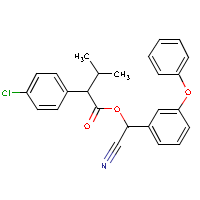Fenvalerate
Agent Name
Fenvalerate
CAS Number
51630-58-1
Formula
C25-H22-Cl-N-O3
Major Category
Pesticides

Synonyms
(+)-alpha-Cyano-3-phenoxybenzyl-(+)-alpha-(4-chlorophenyl)isovalerate; (Cyano(3-phenoxyphenyl)methyl-4-chloro-alpha-(1-methylethyl)phenylacetate); (RS)-alpha-Cyano-3-phenoxybenzyl (RS)-2-(4-chloro-phenyl)-3-methylbutyrate; (RS)-alpha-Cyano-3-phenoxybenzyl (RS)-2-(4-chlorophenyl)-3-methylbutyrate; 4-Chloro-alpha-(1-methylethyl)benzeneacetic acid cyano(3-phenoxyphenyl)methyl ester; Agrofen; Aqmatrine; Belmark; Cyano(3-phenoxyphenyl)methyl 4-chloro-alpha-(1-methylethyl)benzeneacetate; EPA Shaughnessy Code: 109301; Ectrin; Evercide 2362; Fenaxin; Fenkem; Fenkill; Fenoxin; Fenval; Fenvalerate; Furitrothion; Gold crest tribute; Insectral; OMS-2000; Phenoxin; Phenvalerate; Pydrin; S 5602; S-5602; SD 43775; Sanmarton; Sumibac; Sumicidin; Sumicidin 20E; Sumifleece; Sumifly; Sumipower; Sumitick; Sumkidin; Tirade; Tribute; WL 43775; alpha-Cyano-3-phenoxybenzyl 2-(4-chlorophenyl)isovalerate; alpha-Cyano-3-phenoxybenzyl alpha-(4-chlorophenyl)isovalerate; alpha-Cyano-3-phenoxybenzyl alpha-isopropyl-4-chlorophenylacetate; alpha-Cyano-3-phenoxybenzyl-2-(4-chlorophenyl)-3-methylbutyrate; Benzeneacetic acid, 4-chloro-alpha-(1-methylethyl)-, cyano(3-phenoxyphenyl)methyl ester; Cyano(3-phenoxybenzyl)methyl 2-(4-chlorophenyl)-3-methylbutyrate; alpha-Cyano-(3-phenoxyphenyl)methyl-4-chloro-alpha-(1-methylethyl)benzeneacetate; [ChemIDplus] UN3352
Category
Pyrethrins/Pyrethroids
Description
Yellow liquid; [HSDB] Yellow or brown viscous liquid; [ICSC] Formulated as emulsifiable concentrates, ultra-low volume concentrates, dust powders, and wettable powders; [INCHEM HSG]
Sources/Uses
Used as an insecticide and medication; [HSDB]
Comments
Allergic contact dermatitis reported in farmers; [Kanerva, p. 1796] Pyrethroids have low toxicity to humans after dermal exposure. Of 573 dermal or ingestion poisoning cases in China, 51 patients had disturbed consciousness and 34 had seizures. Of those, only five were occupationally exposed. Seizures are more commonly related to exposures to fenvalerate, flucythrinate, cypermethrin, deltapermethrin, and fluvalinate. Seizures have not been reported after exposure to permethrin. Pyrethroids may also cause paresthesias after skin contact. Paresthesias (stinging and numbness) usually begin 1-2 hours after contact and resolve within 24 hours. [EPA Pesticides, p. 87-8] Pyrethrins cause liver injury when fed to animals at high doses. [EXTOXNET] A skin, eye, and respiratory tract irritant; May cause skin sensitization; May have effects on the nervous system; [ICSC] Occupational exposure may cause skin sensations and paresthesia; [INCHEM HSG] A skin and strong eye irritant; Toxic by ingestion; [Aldrich MSDS]
Restricted
US registration voluntarily cancelled by registrants in 2008; [EPA]
Reference Link #1
Biomedical References
Exposure Assessment
Vapor Pressure
1.5E-09 mm Hg
Explanatory Notes
The Guide in the Emergency Response Guidebook is for "Pyrethroid pesticide, liquid, toxic."
Reference Link #2
Adverse Effects
Skin Sensitizer
Yes
Neurotoxin
Other CNS neurotoxin
Hepatotoxin
Hepatoxic (a) from occupational exposure (secondary effect) or (b) in animal studies or in humans after ingestion
IARC Carcinogen
Not classifiable
Diseases, Processes, and Activities Linked to This Agent
Diseases
Occupational diseases associated with exposure to this agent:
Processes
Industrial Processes with risk of exposure: